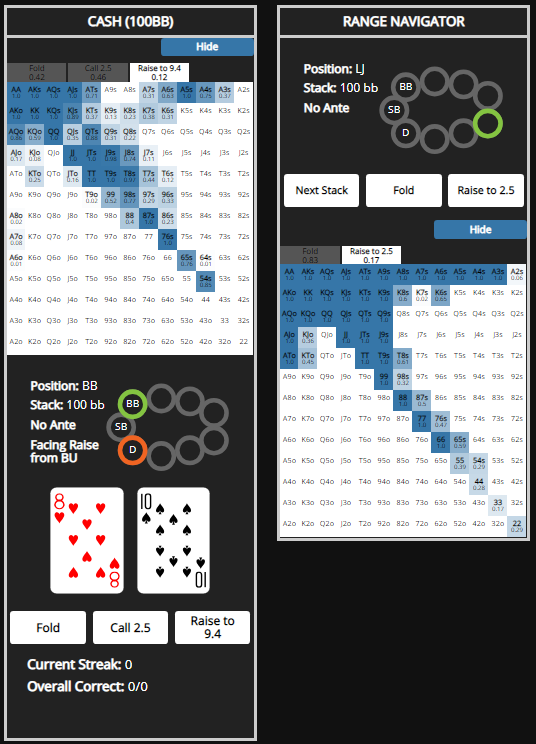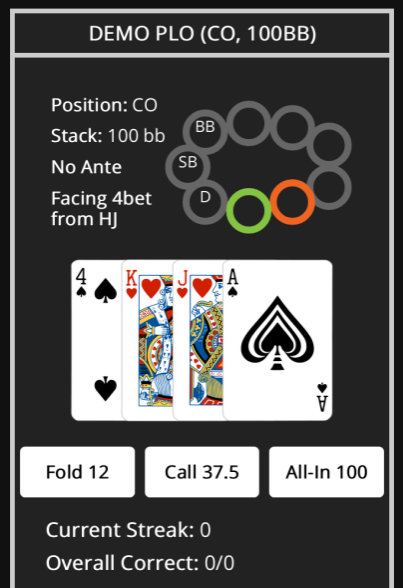Frequently Asked Questions
A simple example is if you were playing competitive rock-paper-scissors. The GTO strategy is 33.3% rock, 33.3% paper, 33.3% scissors. If you do anything else as your strategy, you open yourself up to getting exploited. You can extend this to more complicated games like poker, which has a much more complicated GTO strategy.
For Tournament modules, the RFI ranges from 2-2.5bb with 3bet and 4bet sizes depending on the stack size. With the shorter stack sizes, smaller 3bet or 4bet sizes are chosen to always leave raise-fold as a reasonable option for the solver.
When A and B versions of a module exist, they use different sizings for raises/3bets/4bets/etc.
The PLO modules use pot-sized raises. PLO HU A uses a raise/fold strategy from the SB. PLO HU B uses a limp/raise/fold strategy from the SB.
In RNG mode, each question comes with a randomly generated number from 0-100. The higher the number, the more you should lean towards the more aggressive action.
For example: suppose the optimal strategy is 30% Fold, 25% Call, 45% Raise. In the default mode, the correct answer is Raise since that has the highest %. In RNG mode, if the RNG is < 30, then the correct answer is Fold. If the RNG is between 30 and 55 the correct answer is Call. If the RNG is > 55 (30+25), then the correct answer is Raise. This mode helps you to implement the mixed strategies with the right frequencies.
For 6-max PLO: the PLO (micro) rake levels are 4.5% with a 10bb cap (~$10 PLO). The PLO (mid) rake levels are 5% with a 2.5bb cap (~$100 PLO). The PLO (high) rake levels are 5% with a 0.6bb cap (~$500 PLO).
For HU PLO: the PLO (mid) rake levels are 5% with a 0.625 cap (~$200 PLO). The PLO (high) rake levels are 5% with a 0.3bb cap (~$500 PLO).
There are both rake and no-rake NL cash game modules. NL 50 (midA) uses 5%, 6bb cap. NL 50 (midB) uses 5%, 3bb cap, with preflop 3bets also raked. NL 50 (midC) uses 5%, 2.5bb cap. NL 50 (high) uses 3%, 0.83bb cap. NL 100 (midA) uses rake of 5% up to a 2.5bb cap (~$100 NL) and NL 100 (midB) and (midC) has rake of 5% up to a 3bb cap with preflop 3bets+ also raked (the difference is midB is 3bet/fold whereas midC allows cold-calls in all positions). NL 100 (midD) is 5% up to 3bb cap (similar to midA but with no cold-calling except from the big blind). NL 100 (high) is 5% up to 0.75bb cap. HU 100 (midA) uses 5% with a 1.5bb cap. HU 100 (midB) uses 5% with a 0.625bb cap. HU 100 (midC) uses 3% with a 0.375bb cap.
In simulations with rake, the solver naturally assumes all other players are also rake-aware (folding when they should, cold-calling less, etc). For example, in a raked NL game, the solver will open wider in earlier positions and prefer opening hands like A5o (better for blocking our opponent's 3-bet range) over hands like 65s (better for postflop play/board coverage). The solver will also 3bet hands which block our opponent's 4-bet range more heavily (as the solver assumes that the opponent will be 4-betting our 3-bets more often).
If players in your game are not adjusting accordingly (i.e. too much cold calling with not enough 3-betting or 4-betting), then you might make adjustments such as 3-betting a more linear range or opening hands with better postflop playability (or playing tighter than the RFI ranges suggest). In general, we would recommend starting with no-rake ranges to have a good baseline/fundamental strategy and then explore the differences in raked simulations to see what deviations are made when there is rake.


We (in green) opened to 2.5x and villain (in orange) 3bet to 6x.
Now our options are to fold (and lose the 2.5x we've put into the hand), call the raise of 6, or go all-in for 25.
A more complicated example:

Call 37.5 implies that the villain's 4bet size is to 37.5x.
Fold 12 implies that our previous raise was to 12x.
So we can infer that the hand began with villian opening. Then we 3bet to 12x. Now villain 4bets to 37.5x and the action is on us. We can either fold (and lose the 12 we've put into the pot already), call the 37.5, or go all-in for 100.
At the moment you can assume all scenarios involve at most two players (with everyone else folding). We plan to add more multiway scenarios in the future.
Pro Plan Pricing
Unlimited practice questions
NL Tourney Modules
NL Cash Modules
NL Range Viewer
PLO Modules
Cancel anytime

